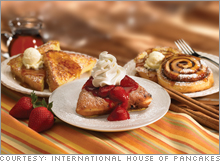Investors flip over IHOPThanks to a new business model, cash is pouring into the breakfast restaurant chain like syrup over so many pancakes. Shares are up, and could go even higher.(Fortune) -- If your grandmother says that breakfast is the most important meal of the day, then your broker might say that free cash flow is the most important financial metric. So why not treat yourself to both with IHOP Restaurants? The national breakfast restaurant chain is not only a still-growing business, it's become a cash-flow machine. That makes it both a safe stock to hold value and one with some nice upside potential. Free cash flow, as you probably know, is money left over after all the company's expenses, and it can be used to help keep a business growing during a slow year or be spent on ambitious investments like acquisitions or stock buybacks. This makes it a good metric to look at when evaluating a company's financial health (do they have savings in the bank to weather a downturn?) and the potential for its stock to grow.
And right now, the cash is pouring into IHOP (which used to be known as International House of Pancakes) like syrup over so many hotcakes. That's because in 2003, IHOP (Charts) changed its franchise model from cash-intensive to cash-generating. While it once would buy the land, build the restaurant, then sell it to a franchisee, IHOP now only sells its name to the franchisee then lets them buy the land and do the building. IHOP might earn a little bit less profit on the transaction, but it doesn't have to spend as much money to make money. IHOP's cash flow in 2005 was $47.9 million on revenues of $354 million. It's projected to grow to about $80 million this year. Merrill Lynch analyst Rachael Rothman in a recent note called IHOP's cash flow "one of the strongest in the restaurant industry" and slapped a "buy" rating on the stock. The business's low overhead is also generating higher profits. Analysts agree with management's projected 2006 EPS of at least $2.34, which would be up 10 cents from last year and way above its five-year average of $1.87. As a result of all this good news, the restaurant's stock is up 15.5% over the past year, trading at around $54, but it's still a good time to jump on the bandwagon. First, consider the long-term benefits of cash flow: the potential for buybacks and acquisitions. IHOP has bought back 5 million of its own shares since 2003, and plans to buy 2 million more, at an average of about $54 per share, according to Merrill Lynch. That means many shares are being bought at a premium, which is sure to keep nudging the stock upward. As for acquisitions, management hasn't said anything specific about buying another chain or business, but it has said it's keeping its eyes open. That might be another family chain to fold into the IHOP network, or a big push into Canada or Mexico. Either way, it's a good bet that if organic growth slows, IHOP will seek it elsewhere. Second, the chain is growing at a fast clip. IHOP has a pipeline of 498 franchisees ready to add to its network of 1,278 existing restaurants in the U.S. and Canada. While a traditional franchise business has the potential to grow too quickly, since adding stores is as easy as selling the name, IHOP is still trying to be discriminating. About 75% of the new stores would be owned by current franchisees, and 100 of the 498 are still being evaluated before they're finalized. IHOP's royalty revenues from its franchisees are also growing. Since IHOP collects a 7.5% cut of the top line from all its franchisees, it does better as its restaurants do better. Partly due to two big promotions ("Funnel Cake Festival" and "French Toast Fantasy"), the number of visitors to existing IHOP restaurants was up 1.5% in the third quarter of 2006, according to analyst Michael Gallo of CL King, and same-store sales grew 1.3%. Of course, IHOP's exposure to its franchisees' restaurants also presents risks. IHOP shares the same challenges as other chains in the fast-casual sector: increased competition, a trend toward more upscale dining, and the risk of slower sales due to shrinking wages or falling home values. In general, "midscale" restaurants - a category that also includes IHOP, Denny's (Charts), Bob Evans (Charts), and Darden's (Charts) Olive Garden - were slightly down in traffic in 2005, according to NPD Group. But next year promises to be a good one for IHOP. Analyst Gallo says in a recent note that IHOP's new menu (all franchisees carry the menu) rolling out this month will give stores the opportunity to raise prices - which they didn't do while gas prices were increasing. IHOP is also rolling out a new "to go" menu, which has done well at Applebee's (Charts), a chain with a similar business. One note of caution, however: Some might say that IHOP's cash flow make it a good target for private equity. But remember that buyouts of restaurant chains - like the recent takeover of Outback Steakhouse (Charts) - usually make sense because of the value of the real estate, which can be sold to pay off debt. Since IHOP is a franchiser, it doesn't own much land. So while it's a great stock to hold, don't expect someone to come along and buy it at a huge premium. |
Sponsors
|

